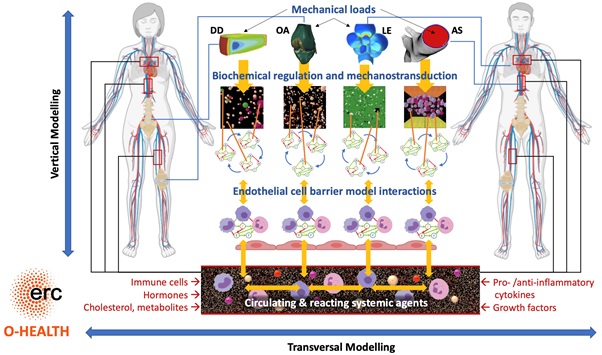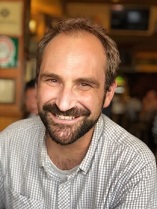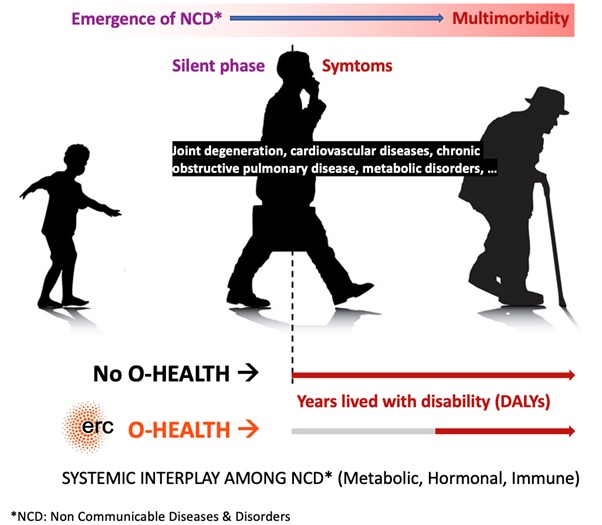Jérôme Noailly receives a grant from the European Research Council for a project on the prevention of noncommunicable diseases
Jérôme Noailly receives a grant from the European Research Council for a project on the prevention of noncommunicable diseases
Jérôme Noailly receives a grant from the European Research Council for a project on the prevention of noncommunicable diseases
The O-Health project aims to advance in the prevention of noncommunicable diseases that, due to the invisibility of their initial symptoms, are complex to diagnose. Such diseases include atherosclerosis, the degeneration of the intervertebral discs, knee osteoarthritis, and pulmonary emphysema.

The O-Health project to prevent and anticipate risk factors for noncommunicable diseases (NCDs) such as atherosclerosis, intervertebral disc degeneration, knee osteoarthritis and pulmonary emphysema will be supported by a Consolidator Grant (CoG) from the European Research Council (ERC). The UPF researcher directing the project, Jérôme Noailly, has received the CoG, a prestigious grant for innovative, high-risk projects with high potential scientific or technological impact to help the directors of the group to set up new research teams.

With funding of 2 million euros over five years, Noailly is one of the 19 selected in Spain, eight in Catalonia, in the call (ERC-2021-CoG). O-Health is the only Spanish project awarded by the ERC’s Products and Process Engineering panel (PE8).
Noncommunicable diseases (NCDs) are caused by a combination of factors, such as genetic predisposition or physiological, environmental, behavioural, and age-related factors. Examples of such diseases include musculoskeletal disorders, chronic respiratory diseases, cardiovascular diseases, cancer, and metabolic disorders, among others.
Noailly explains that the project aims to advance in the prevention of diseases that, due to the invisibility of their initial symptoms, are complex to diagnose
The O-Health project seeks to advance the prevention of these diseases in order to respond to the difficulties presented in their diagnosis at the earliest stages of their development. The physiopathological mechanisms associated with these diseases may begin several years before their symptoms manifest and a clinical diagnosis is reached. “Their subclinical evolution, which is invisible, can be very slow until the first symptoms appear”, says professor Jérôme Noailly, who leads the area of Biomechanics and Mechanobiology at UPF’s Barcelona Centre for New Medical Technologies (BCN MedTech).
NCDs involving organs that bear mechanical loads, such as the arteries, joints, or lungs, involve particularly complex silent development mechanisms. The cells of the tissues of these organs are mechanosensitive; that is, they have the ability to feel and respond to mechanical loads. “In a normal biological environment, this mechanosensitivity allows cells to keep the tissue in a fully functional state”, the researcher explains. “However, in the presence of biological disturbances, such as those caused by genetic variants or metabolic disorders, changes in the interaction between biology and mechanics cannot be measured directly and are difficult to infer through clinical explorations alone. In addition, a person’s lifestyle is an added factor that affects both the body’s daily mechanics and its biological regulation. There is, therefore, a great need to describe and interpret a complexity that we have not been able to measure until now” – Noailly states.
With current means of health exploration, such invisibility hinders the early prevention and diagnosis of NCDs. This has led to an increase in the period of time during which people who contract these diseases live with some type of disability, and more so considering that life expectancy has increased. In addition, the increase in the incidence of NCDs worldwide over the past 20 years should be taken into account. According to the latest global health metrics published (GBD 2019), NCDs accounted for 70% of the top 10 most lethal and disabling diseases among the global population between the ages of 25 and 49. The ones with the highest incidence are cardiovascular diseases (in 3rd position), followed by lower back pain (in 4th place).

The O-Health project addresses the problem of understanding the development of diseases such as atherosclerosis, degeneration of the intervertebral discs, knee osteoarthritis and pulmonary emphysema their silent phase
The O-Health project addresses the problem of understanding the development of NCDs in their silent phase and represents a further step in the research conducted by Noailly to date. For over 20 years, he has been developing and using multi-scale in silico modelling, which consists of integrating knowledge, data and hypotheses into mathematical models that are solved via computational calculation techniques. “Our previous research in the fields of intervertebral disc degeneration, knee osteoarthritis, pulmonary emphysema and atherosclerosis, leads us to think that multiscale in silico modelling does allow this understanding of the relationship between cellular dynamics and NCDs that affect specific organs, when analysing the cross effects of changing biological and mechanical environments.
With the O-Health project, more progress is made in this field of research to “take into account that the entire body is a system where the organs are interconnected”, Noailly explains. O-Health proposes a new type of transversal computational modelling, which represents the interaction between specific NCD models through systemic blood circulation. The specific NCD models that will be “connected” to the transversal model will be atherosclerosis, intervertebral disc degeneration, knee osteoarthritis and pulmonary emphysema.
In each of these models, called vertical models, the cells are mechanosensitive. The combination of physical models of the deformation of organs and tissues, with small-scale computational biology models, will enable integrating the crossed influences of the mechanics and biology on the positive or negative evolution of cells.
As a result, risk factors for NCDs will be able to be predicted long before the tissues become functionally altered, so it is expected to reduce the time that people with NCDs suffer disabilities as a result. The systems biology models of each vertical NCD model will communicate with the transversal systemic model, allowing relating the risk factors with the overall body health status. Specifically, for the first time, the multiple interactions with the transversal model will facilitate taking into account the influence of metabolic disorders, hormonal imbalances and immune system disequilibria.
The O-Health project “simulates the whole body through systemic variables present in low-grade inflammation, hormonal, and metabolic regulation”
“O-Health is an unprecedented proposal for the scalable integration of NCD models that simulates the entire body through systemic variables present in “low-grade inflammation”, hormonal, and metabolic regulation”, Noailly stipulates. “For example, there are already cardiac and vascular models that allow interpreting electrocardiograms down to the detail of cardiac electrophysiology or simulating whole body blood circulation. If these models are coupled to the O-Health system, they would have an impact far beyond the scope of a specific disease”.
In technological terms, all O-Health models will be designed to be interoperable, enabling viewing a “plug and play” system (which only needs to be connected to be used) of vertical NCD models produced by other research groups, all of which can be connected to the systemic transversal model. The interoperability of the transversal model will be designed to improve, over time, the descriptions of the metabolic, endocrine and immunologic functions involved in systemic communication.
Collaborations with international centres working with biological and clinical data
The development of O-Health also requires biological and clinical data for its calibration and validation. The project foresees collaborating with large population cohorts like Twins UK and the Northern Finland Birth Cohorts, and data science will be one of the central aspects of O-Health, both for the development of the technology and for its use. In particular, models based on O-Health data will be key for the set of simulations to be customizable according to data on life habits, sex, age and known comorbidities.
The O-Health system will be accessible and will integrate knowledge accumulated over 20 years of research
The O-Health system will be accessible through a web interface, connected to a set of specialized, synchronized computers for the morphological modelling of organs, the calculation of the mechanics of organs and tissues, the calculation of computational biology and the management and mining of data.
“O-Health is a vision of the future that integrates knowledge accumulated over about 20 years of our research, by other researchers of BCN MedTech, and during decades of research by such communities as the Virtual Physiological Human, which work to promote in silico, personalized and predictive medicine”.
“We believe that if we can anticipate the silent physiological relationships between several NCDs at corporal level in young adults, we will be able to dramatically increase people’s disability-adjusted life years (DALYs)”.
The BCN MedTech will also be collaborating in the O-Health project through professors Gemma Piella and Miguel Ángel González Ballester, directors of the Simulation, Imaging and Modelling for Biomedical Systems (SIMBIOsys) group. They are experts in data science, machine learning, and medical image analysis and processing. “We believe that if we can anticipate the silent physiological relationships between several NCDs at corporal level in young adults, we will be able to dramatically increase people's disability-adjusted life years (DALYs)”, Noailly concludes.
